Who is Today’s “Typical” Learner?
It’s fall. “Back to school” ads monopolize print media and the airwaves. In one, a nervous 18-year-old girl pauses, afraid to open the letter that will tell her whether or not she’s gained admission to the college of her choice. Her worried but empathetic parents offer encouragement. They only want the best for their daughter.
If we buy what the advertisers are selling, then we imagine a campus peopled by this young woman and her male counterpart. They define the iconic “college students” we are shown this time each year. However, the students on real twenty-first century campuses–and even more their virtual “campus” counterparts–little resemble these ideal coeds of yesteryear.
Who are today’s students? By and large, working adults comprise today’s student population. Most are financially independent. Some have dependents of their own. Their economic backgrounds and full lives make getting a higher education tough–but not impossible. To government number crunchers and academic admissions counselors, they collectively define themselves as “nontraditional” students. What does this label mean?
Nontraditional Students
The National Center for Education Statistics (NCES) defines a “nontraditional student” as a student with at least one of these seven characteristics:
- Does not enter college immediately after high school.
- Attends part time rather than full time.
- Works 35 hours a week or more.
- Is financially independent as defined by financial aid criteria.
- Has dependents other than a spouse.
- Is a single parent.
- Lacks a high school diploma (though may have a GED or other high school equivalency).
Of course, a single mother who works full time and takes evening or online classes toward a bachelor’s degree isn’t unusual. If trends continue, she will become the norm.
Demographics suggest that some of the qualities defining a student as “nontraditional” by government standards have become quite common. According to statistics cited by Peter Stokes of Eduventures, an educational research and consulting service, nontraditional students account for a significant portion of today’s college student population. At least 40 percent of students are part-timers, 40 percent opt for two-year rather than four-year schools, and fully 58 percent are past “traditional” college age.
Think “soccer mom” and you’ll imagine the “average” adult learner reported in Recruitment & Retention in Higher Education: a 35-year-old white, middle-class, married mother who’s active in her community. Across the board, women will outstrip men in educational achievement, according to projections by the National Center for Education Statistics:
Associate’s Degrees by Gender(in thousands)
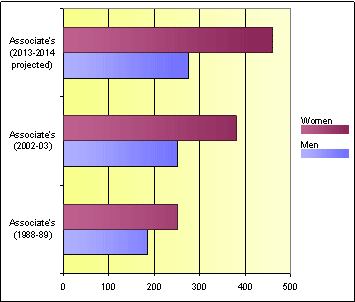
Bachelor’s Degrees by Gender(in thousands)
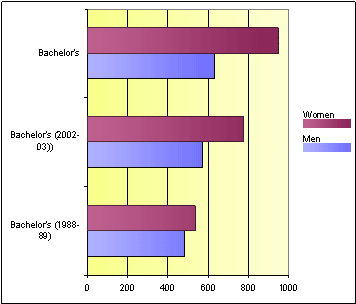
Government statistics also predict an increase in the number of graduate degrees attained by women. For the first time in our educational history, women will outstrip men in the number of doctoral degrees attained:
Master’s Degrees by Gender(in thousands)
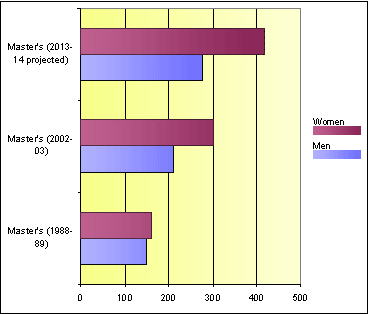
Doctoral Degrees by Gender(in thousands)
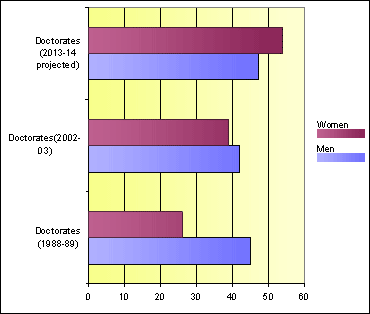
The number of financially dependent fast-track fulltime students has shrunk to a mere 16 percent of the student body. The online student demographic picture differs only slightly from the new look of the campus student body since it includes a larger minority population. Long-term government statistical research projects escalating enrollments across all age categories for degree-seekers. Though part time study steadily declined in the 1990s, part timers will number more than 7.5 million by 2014.

On many of today’s campuses, the student populations are indistinguishable from the cross-section of people you’d see in any mall across the U.S. As a result, both educational funding and higher education itself are adapting to meet the needs of this new student body.
The Impact of Nontraditional Students on Higher Education
As a group, nontraditional students have changed the way that higher education operates. Here are some twenty-first century trends in education that may reshape the face of higher learning:
The old idea of a well-rounded education is giving way to a career-oriented work training model.
This profound shift in educational expectations fuels every other change in twenty-first century education. Whereas students used to get broad exposure through a core general education in both arts and sciences, today’s stripped-down, career-focused degree programs ever more closely resemble training programs.
Time to degree is increasing for conventional degree programs and decreasing for fully online programs.
The old four-year model of the bachelor’s degree assumes a traditional full-time student taking five courses (15 credits) per semester. In that same time, an online student could take only three courses, where courses are offered singly and in sequence. Nevertheless, well-established online universities may offer a bachelor’s degree in two to three years.
Fast-track courses and intensive programs mean a new form of study.
The career school model–which compresses the fifteen-week semester course into five weeks (or twenty hours of course meetings total)–dominates for-profit, online, and career training schools. The standard two-year MBA has shrunk to ten months of fast-paced, intensive study in some programs.
Fully online degree programs now abound.
Eduventures reports that in 2005, 1.2 million post-secondary students were “enrolled in fully-online certificate or degree programs.” These degree programs best fit the needs of fulltime workers.
Government funding favors the out-the-door-and-into-the-workplace model of education as job training.
In FY 2007, the Federal Government will again provide more than $80 billion in student aid to about 10 million postsecondary learners, including more than $5 billion in Pell Grants to needy students. The emphasis on training, however, becomes clearer in the breakdown of proposed funding for the Employment and Training Administration.
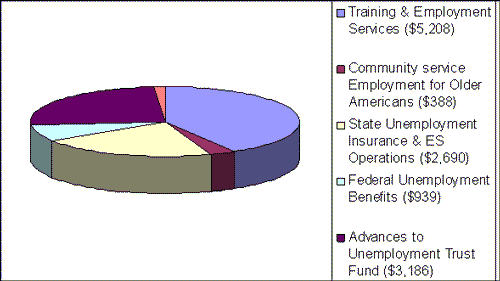
Proposed ETA Funding (FY2007) in millions of dollars
Of the 2007 proposed Training and Employment budget above, $3.4 of the $5 billion is earmarked for Career Advancement Accounts, to be administered by the states. With such an account, a student could borrow up to $3,000 a year for two years (the average educational expenses at a community college).
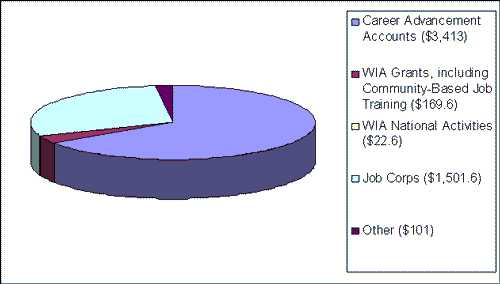
Distribution of Training and Employment Funds in millions of dollars
Proposals to fund short-term training (as little as 10 weeks) and absence of funding for living expenses suggest that CAAs are intended mainly for nontraditional students seeking training: adult learners, displaced working adults, and high school dropouts.
At-Risk, Nontraditional Students
The seven characteristics that define a nontraditional student all make it more difficult for that student to get an education. Work demands a significant amount of the nontraditional student’s time, so finding time to attend classes–much less study–requires lots of self-discipline. The ongoing demands of family life can easily shove studying into the background. Rarely discussed, yet most important of all, the gap between high school and college and the lack of a high school diploma mean that nontraditional students may find themselves unprepared for the rigors of college-level coursework. Little wonder, then, that many nontraditional students drop out in their first year of study–without ever taking advantage of the many programs in place to support them.
In general, the larger the nontraditional student population of a school, the greater the school’s commitment to helping at-risk students complete their degrees. At Wilson College, for instance, where three out of every four students are nontraditional learners, the school’s commitment to childcare has been key to student success. At Mount Saint Mary, a small liberal arts women’s college, longer library hours, flexible course schedules, and aggressive job placement give nontraditional students the additional push they need to succeed. Though online study solves the childcare, commuting, and scheduling issues, online schools have found that they, too, need to offer the tutorial support and placement services that get nontraditional students out the door and into jobs.
Not Getting an Education Isn’t an Option
A simple comparison between the education that Americans have and the education they’ll need portends a coming crisis for uneducated working adult age 25 and older. In 2004, a mere 28 percent of this group had a bachelor’s degree or better. Unfortunately, 63 percent of the 18.9 million new jobs created in the coming decade will require at least a bachelor’s degree.
Bachelor’s degrees are central to the three sectors that the BLS expects to account for the bulk of the decade’s job growth: Educational Services (32.5%), Health Care and Social Assistance (30.3%), and Professional and Business Services (27.8%). Not surprisingly, online universities, which cater to the needs of nontraditional students, also concentrate their degree offerings in these three areas. Consequently, government projections confirm the predictions for continued strong growth in online education.
Tips for Nontraditional Students
If you’re nervous about entering or returning to school as a nontraditional learner, let me give you some advice on how to succeed. This advice comes both from my twenty-plus years experience as a university educator and from my student experience. You see, I’ve been both a traditional and a non-traditional student. Twenty-five years separate my B.A. degree from my Ph.D. So, I know what it’s like to return to school after a long absence–and my students have taught me about returning after job loss or divorce.
- Make up any skill deficits before you attempt any higher level study. You must have college level reading, writing, and math skills to succeed. Fortunately, most institutions–both campus and online schools–offer some form of remediation to students who need it.
- Once you’re up to speed with your study skills, enter your degree program with a realistic plan. The average adult learner takes upwards of five years to complete a degree. Adult learners who get impatient and take on too much, too soon are the most likely to drop out–or perform so badly that they have to enter the job market without letters of recommendation from their professors.
- Take advantage of all the support you can find–and plan to devote time and energy to researching and applying for financial aid. You’ll need to make getting (and keeping and renewing) aid an ongoing part of your education.
Remember: as a nontraditional learner, you’re part of the new tradition in higher education. You’re hardly alone. And if you think you’re too old to pursue a degree that significantly increases your earning power, ask yourself one thing: How old will you be if you don’t go back to school?
